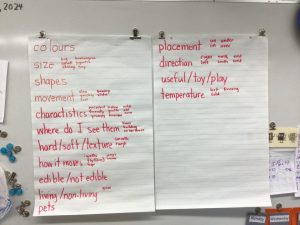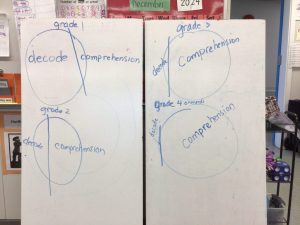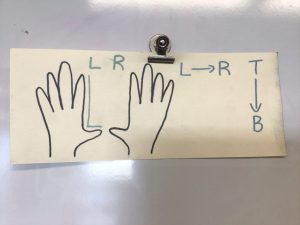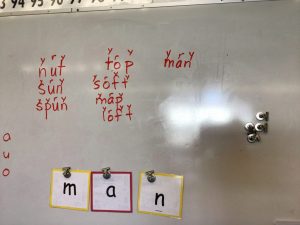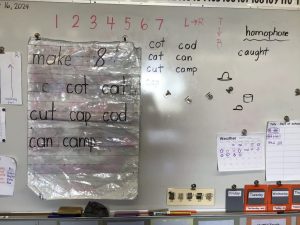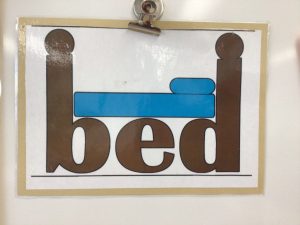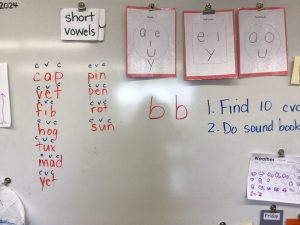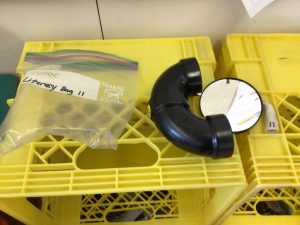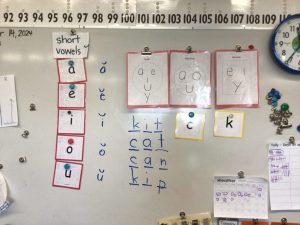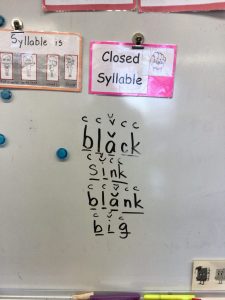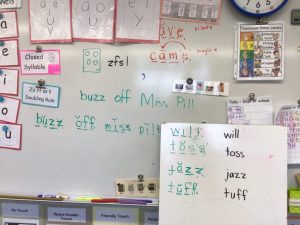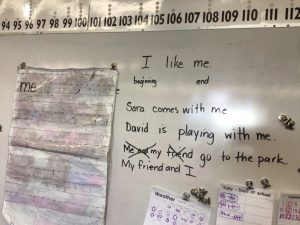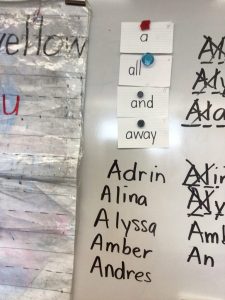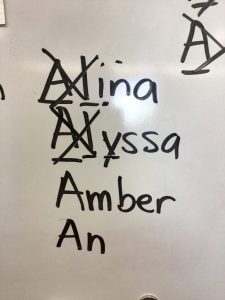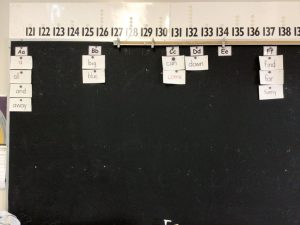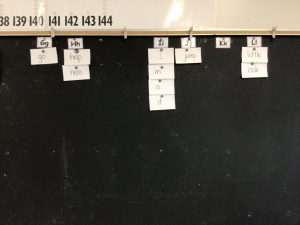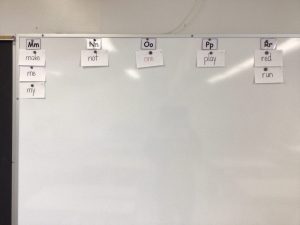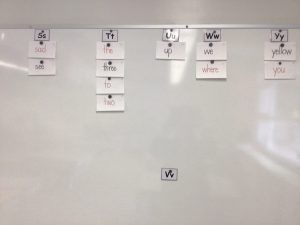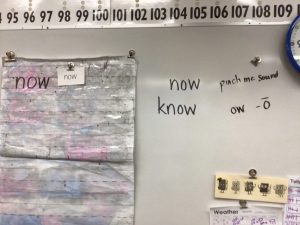Our Learning (Literacy)
Story Workshop
In December, we began story workshop, and we are nurturing ourselves as authors. We brainstormed ideas of the kinds of words we can use when we are writing.
Components of Reading
Reading has two components, decoding and comprehension. When we begin learning to read, the decoding component is really important. We need to figure out what the letters on the page mean. As we become more familiar with reading, the comprehension becomes important. This is what we do for the remainder of our lives, which is understanding what information is given by the words. If decoding is still weak, we need to strengthen it so we can move onto the comprehension.
Beginning Stages of Reading
As of Oct. 10, we have learned ten phonemes that start the reading process. The concept of left and right is important in many aspects of our life in North America, such as driving on the right side of the road, putting on our shoes on the correct foot, or giving directions to others. Knowing left and right is also and important foundation for reading, writing, and math. Keeping in mind the idea of going left to right, we used the ten phonemes to read words. This is the beginning stages of reading. We also noticed that some of the cards have letters that are yellow and some of the cards are red. These are the words we read remembering our left to right.
During the week of Oct. 15, we continued with our letter sounds and reading words. We are also learning to print the word by practicing the proper letter formation and remembering which letters are tall, short, or hang down. We are also learning that some words sound the same but are not spelling the same. These are called homophone.
During the week of Oct. 28-Nov.1, we looked carefully at the letters b and d. If we read also the alphabet, b comes before d. If we follow the rules for reading and read left to right, we will see the stick of the b first and then the ball (hence, “bat and then the ball”). We also learned that b and d are on our hands. If we make a binocular with our hands and put up our index (pointer finger) we will have the b on our left hand and d on our right hand. If we also keep in mind the word ‘bed’, we can see that the circle portion of the letters makes up part of the mattress, and the stick part makes up the bedposts.
CVC words (Consonant Vowel Consonant)
Phonemic Awareness
We began working on phonemic awareness on September 23. Please note that reading and writing go hand in hand. Most often, children will become fluent readers before becoming fluent writers. However, the two go hand in hand and the skills we learn for reading are necessary skills for writing. Please look at the list below to see what we have been working on. We talked about how letters have names, like we do, but they also have a sound that they say (these are called phonemes). The slant marks on either side of the letter are called “virgules” (/_/) and they indicate the sound that they make. Letters are either vowels or consonants. The placement of their tongue, whether the mouth is open or closed, and whether we blow through our teeth change the sound of the letter. Formulation of the sounds (articulation) is important when speaking, but it is important in reading and writing as well. We use a ‘hearing phone’ to help us hear the correct pronunciation and we use a mirror to ensure that our mouth and tongue formation is correct.
On the week of Oct. 7, we also talked how some sound are continuous sounds (/a/short vowel, /s/, /m/, /l/, /f/, /n/, /o/short vowel) where the sound continues until we run out of breath. Some sounds are quick sounds (/p/, /t/, /u/short vowels).
During the week of Nov. 12, we learned that there are five vowels (a, e, i, o, u). There are two kinds of vowels: round vowels (a, o, u) and stick vowels (i, e, y – when y travels in the word). When we write CVC words (consonant, vowel, consonant), there is a short vowel sound in the middle. We also learned that c usually goes with the round vowels and the k usually goes with the stick vowels. We say usually because there are always exceptions in English (get, kangaroo)
With relation to the words that begin with the /k/ sound, words that have a “round vowel sound” after the /k/ usually use a ‘c’ like cat, camp, cot, or cantaloupe, and words that have a “stick vowel sound” after the /k/ sound usually use a ‘k’ like kick, kitten, or keep. ‘Kangaroo’ is the only exception I can think of.
- /hard g/ sound also goes with the round vowels to make words like ‘goat’, ‘gust’, ‘gap’ and the other consonants, ‘great’, ‘greet’
- /soft g/ sounds like /j/ when e or i stands beside the g such as ‘George’, ‘giraffe’, ‘ginger’, ‘generation’ (example of some exceptions: get, gift)
- /hard c/ sound goes with the round vowels to make words like ‘cup’, ‘cat’, ‘cot’ and with the consonants ‘crater’, clear’
- /soft c/ sounds like a /s/ when it is next to the stick vowels sounds (e, i, y) in words like ‘celery’, ‘Cecilia’
Letter Sounds or Phonemes
- /a/ (short vowel sound as in apple) (mouth wide open, tongue is in the mouth but visible)
- /s/ (as in snake) (teeth clenched and lips open)
- /m/ (as in mitten) (lips are together like we are humming)
- /l/ (as in leg) (tongue is out touching our upper front teeth)
- /f/ (as in feather) (top upper teeth are over our bottom lip and blow)
- /n/ (as in nest) (face is scrunched and make a nasally sound)
- /o/ (short vowel sound as in octopus) (mouth is open make)
- /t/ (as in teapot)
- /p/ (as in pig)
- /u/ (short vowel sound as in up or umbrella)
- /d/ (as in dog)
- /c/ (hard c as in cat; usually goes with the round vowels and many consonants)
- /k/ (as in kite; has the same sound as “hard c” sound)
- /g/ (as in goat; this is known as a “hard g” sound; usually goes with the round vowels and many consonants)
- /i/ (short vowel sound as in itch insect)
- /b/ (as in bat the ball)
- /e/ (short vowel sound as in Ed, elephant)
- /r/ (this sounds like ‘ruh’ as in red rabbit)
- /j/ (as in jam)
- /h/ (as in hat. This sound is what is known as “voiced” as we can hear the h sound [/h/])
- /v/ (as in vase)
- /qu/ (/kw/ {k and w sounds together} as in quiet queen. q in the English language is always together with u.)
- /z/ (as in zebra)
- /w/ (as in wagon)
- /x/ (/ks/ {k and s sounds together} as in fox in a box
- /y/ (this sounds like ‘yuh’ as in yo-yo, and it only say ‘yuh’ at the beginning of the word) If the y ‘travels’ to a different part of the word, it usually takes the sound of /e/ or /i/ (examples: gym, funny)
Syllables
Syllable – “A word or part of word with one vowel sound or beat”: Evan has two syllables (/e/short vowel in the first syllable, and /v//a/ short vowel /n/ in the second syllable); Alessandra has four syllables (/a/short vowel in the first syllable, /l//e/short vowel /s/ in the second syllable, /s/ /a/short vowel /n/ in the third syllable, and /d/ /ra/ in the fourth syllable)
- Closed Syllable – the symbol that we use with our hand is a closed fist with our thumb inside, like it is protected by the fingers. (a closed syllable is a word or syllable where the short vowel is protected by one or more consonants such as ‘cvc’ or ‘cvcc’. Examples would be cat, bend, fling, toss, or sprung.) ‘cvc’ is consonant vowel consonant, and ‘cvcc’ is consonant vowel consonant consonant
Rules
There are certain spelling rules that we follow to know when to double, drop, or change when spelling.
- zfsl rule Doubling Rule: “Buzz off Miss Pill” is and acronym that helps us remember which letter we double. If a word has a short vowel, is one syllable, and ends in /z/, /f/, /s/, or /l/ (ends in a “z” sound, “f” sound, “s” sound, “l” sound), we double the last letter. Examples are fuzz, cliff, cross, and smell.
Consonant Digraphs
Consonant digraphs are “two or more letters that make one sound”.
- ng word family (short vowel a with ng is ang as in bang, fang, gang, hang,…; short vowel i with ng as in sing, zing, ping,…; short vowel o with ng as in long, gong, song,…; short vowel u with ng as in hung, lung, sung,…)
- nk word family (short vowel a with nk is ank as in tank, hank, bank,…; short vowel i with nk as in pink, link, mink,…; short vowel o with nk as in bonk, conk, zonk,…; short vowel u with nk as in sunk, bunk, hunk,…)
- sh (s and h together make the /sh/ sound as in hush, fresh, shop, sunshine,… The digraph ‘sh’ can come at the beginning, middle, or end of a word)
- th (t and h together make the /th/ sound as in three, with, moth,… The digraph ‘th’ can be voiced (that, these,…) or unvoiced (with, thought, mother…) (The digraph ‘th‘ can come at the beginning, middle, or end of a word)
- ch (c and h together make the /ch/ sound as in chair, champ, lunch, or finch,… The /ch/ occurs at the beginning or end of a word or syllable; when it is at the end of a syllable or word, it is only after a long vowel, vowel digraph, or consonant such as teach, peach, trench or clinch); however, sometimes, /ch/ makes a hard c sound when the following letter is an ‘r’ (Christmas, Christina, chrysanthemum)
Letter Formation
On September 23, we began learning proper letter formation. Printing letters is an important skill to have as it helps guide the students in become fluent readers (reading and writing left to right, up to down) and better writers. Proper letter formation is important in printing to ensure that there are no mix ups (b and d, and e and g, are often written interchangeably which inevitably gives incorrect spelling errors). At the moment, we are focusing on lower case letters, but will move onto upper case letters later on in the year.
To help the students remember the correct order, these are the sayings we have been using. Please be reminded that we are not learning the letter formation in order of the alphabet, but in conjunction with our phonemic awareness. In our class, we refer to the lower-case letters as being “short”, “tall”, or “hang down”. The “tall” letters (capital letters and numbers included) touch the top and bottom lines, and cut through the middle-dotted line, “short” letters touch the middle and bottom lines, and the “hang down” letters start from the middle line, pass the bottom line and have part of the letter hanging down like our legs hang off of a chair. My reason for teaching lowercase letters first is because most of the letters in print form is lowercase letters, whether we are reading or writing. Uppercase letters are at the beginning of the sentence, at the beginning of proper nouns, and in a title book, article, poem, chapter, etc. We have practiced printing in the air, printing on the someone’s back, and then practicing them on a lined sheet. Please encourage your child to print from left to right, from up to down, so prepare and practice reading.
- a – circle, line down (short)
- s – down and around from side to side (short)
- m – line down, up and over, up and over (short)
- l – tall line down (tall)
- f – up and over, tall line down and cross (tall)
- n – line down, up and over (short)
- o – down and around and stop (short)
- t – tall line down and cross (tall)
- p – line down hang down, and around (hang down)
- u – down and around, line down (short)
- d – circle, tall line down (tall)
- c – down and around and stop (short)
- k – tall line down, slant down to the left, slant down to the right
- g – circle, hang down (hang down)
- i – line down tittle (short)
- b – bat and then the ball (tall)
- e – straight across and up and over (short)
- r – line down, up and and over and hook (short)
- j – hang down tittle
- h – tall line down, up and over
- v – slant down to the right, slant down to the left (short)
- q – circle stop, hang down, flick (hang down)
- z – straight across, slant down to the left, straight across (short letter)
- w – slant down to the right, slant down to the left, slant down to the right, slant down to the left (short)
- x – criss, cross (short)
- y – slant down to the right, slant down to the left, hang down (hang down)
Frequently Used Words
Also known as “high frequency words” or “sight words” are words that are common in many books we read. Becoming familiar with these words will help in the decoding process of reading. These words are posted on the word wall in the classroom and are what I call the “secrets to reading”, This will help your child build reading fluency and writing. Please note that the words that are bolded and italicized are words that do not follow the phonemic rules and cannot be sounded out. They have to be recognized for easier decoding and fluency.
During the week of Oct. 15, the word ‘me’ was one of our word of the day. We noted that the word ‘I’ and ‘me’ refer to the same person. However, we always use ‘I’ at the beginning of the sentence and ‘me’ at the end of the sentence.
Antonyms
The term ‘antonyms’ are words that are opposite to another word. Examples: before/after, no/yes, here/there
Homophones
The term ‘homophones’ are used for words that sound the same but are different words. Examples: four and for; hear and here; one and won; see and sea
Alphabetical Order
On Nov. 14, we began our new set of words (primer). However, because we are starting at the beginning of the primer list, we need to put the words in alphabetical order. We learned that if all the words begin with the same letter, we need to look at subsequent letters to see which word will come first.
The word list as of Nov. 14, 2024
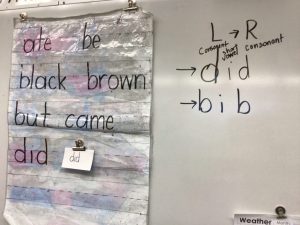 We need to ensure that b and d do not get mixed up.
We need to ensure that b and d do not get mixed up.
 Came is the past tense of come.
Came is the past tense of come.
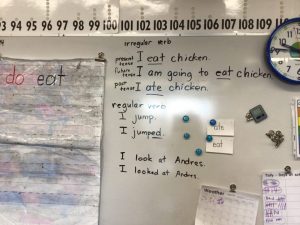 The word, ‘eat’ is the present tense and ‘ate’ is the past tense of the same verb. This is an irregular verb as the base word is not the same (e.g. think/thought, see/saw). Regular verbs have the same base word (e.g. jump/jumped, look/looked).
The word, ‘eat’ is the present tense and ‘ate’ is the past tense of the same verb. This is an irregular verb as the base word is not the same (e.g. think/thought, see/saw). Regular verbs have the same base word (e.g. jump/jumped, look/looked).
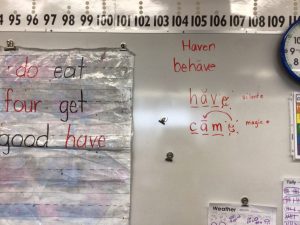 The word ‘have’ does not follow the ‘magic e’ rule (“magic e makes the vowel says its own name”) as the a is /a/short vowel. Instead, the e is just silent.
The word ‘have’ does not follow the ‘magic e’ rule (“magic e makes the vowel says its own name”) as the a is /a/short vowel. Instead, the e is just silent.
- a
- and
- away
- big
- blue
- can
- come – this word does not follow the magic e rule and the o makes the sound of a /u/short vowel
- down – (has “ow” which makes a “pinch me sound ow”, but “ow” also makes a /o/long vowel in words like tomorrow or flow)
- find
- for– this word is used to indicate the place someone or something is going to or toward. This word is a homophone (words that sound the same but are completely different words)
- funny
- go
- help
- here
- I – This word is used when referring to oneself. It is either a letter or stands alone as a word (one of two words in our English language that is a letter or stands alone). When it stands alone, it is always in upper case.
- in
- is – this word is an irregular verb
- it
- jump – this word is a regular verb
- little
- look – regular verb
- make – magic e; irregular verb (it doesn’t follow the past tense rule (past tense becomes ‘made’)
- me – used at the end of sentence
- not
- my
- one – this is for the numeral 1. This word is a homophone (words that sound the same, but are completely different words).
- play
- red
- run – this word is an irregular verb as it doesn’t follow the past tense rule (past tense becomes ‘ran’)
- said – this word does not follow the rule. We actually hear a short vowel in the middle of this word. Also, this word is an irregular verb as it doesn’t follow the past tense rule (present tense is ‘say’)
- see – This word is an irregular verb as it doesn’t follow the past tense rule (past tense becomes ‘saw’); this word is also a homophone (‘sea’)
- the – this word does not follow the rule. We hear a voiced /th/ but the e makes a /u/ or /a/ sound.
- three
- to – this is used in directional content (I am going to the store.; This card is to Mary.) This word is also a homophone (words that sound the same, have different spellings, and are completely different words).
- two – this is the numeral 2. This word is a homophone (words that sound the same, but are completely different words).
- up
- we (pronoun)
- where – this is the asking the directional question. We also talked about how we see the word ‘here’ inside the word, but we do not say the w sound and here together. This word is also a homophone (‘wear’)
- all
- am – this word always goes with ‘I’
- are – this word is the verb “to be” and used when the subject (we, you, they) is the plural form. It has a silent e but does not follow the silent e rule.
- at
- ate
- be – irregular verb; connected to am, is, are, was, were, will be; this word is also a homophone with bee (insect) and Bea (name)
- black
- brown – /ow/ one of the sounds it makes is what I call the “pinch me” sound (what we say if someone pinches us)
- but
- came
- did – this word is an irregular verb as it doesn’t follow the past tense rule (present tense is ‘do’)
- do – the /o/ is pronounced like /oo/; also this word is an irregular verb as it doesn’t follow the past tense rule (present tense is ‘did’)
- eat – this word is an irregular verb
- four – the /ou/ does not make a “pinch me sound”; this word is a homophone to for
- get – this word is an irregular verb
- good
- have – this word does not follow the Magic e rule (the silent e at the end of the word makes the vowel say its own name)
- he – this word is a pronoun
- into
- like – this word has the ‘magic e’
- must – this word is a closed syllable
- new
- no
- now – I have taught them that the ‘ow‘ is the the “pinch me sound” (what we say when someone pinches us). ‘ow’ also makes the /o/long vowel sound.
- on
